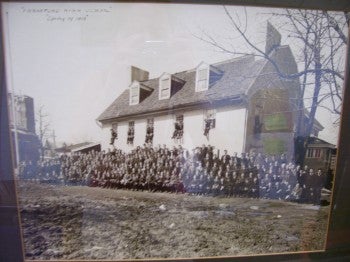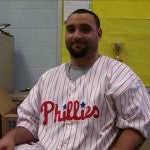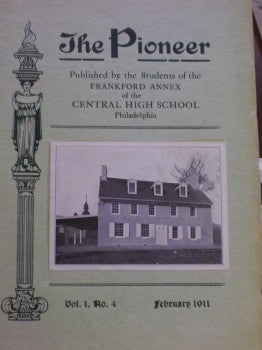Frankford High School: 100 years later

Dr. Thomas Mills, the current Frankford Alumni Association president, graduated from Frankford High School in 1948 with 477 other high school seniors. All but two of the 478 individuals were Caucasian males.
Terry Tobin, the Alumni Association’s financial secretary and treasurer, graduated from Frankford High in 1962. In his first year at Frankford, he witnessed the voluntary desegregation of the school.
Joe Farina, a first-year health and physical education teacher and a wrestling and baseball coach at Frankford, graduated in 2004. Frankford’s demographics during his last year there closely resemble the current statistics.
During the 2008-2009 school year, the most recent school year for which data are available, African Americans made up the majority of Frankford’s student population at 62.4 percent. At 9.9 percent of the student population, Caucasians ranked third. Latinos were second at 25.1 percent. The high school had 1,921 students enrolled that year, quite a jump from the 37 students who attended the Central High School annex its first year, September 1910, 100 years ago.
“I’m not sure how many staff, how many kids, realize what a big deal 100 years is and how much it’s changed over those years,” Tobin said. “How many high schools in Philadelphia are 100 years old? I know of Central, I know of Northeast High School. I’m sure there are a couple others but not many.”
Frankford began as a Northeast branch of Central, which opened in 1838 and is the second-oldest continually operating public high school in the United States and the oldest in Philadelphia. At that time, Frankford High School held its classes in a nearby mansion before moving to its current location at 5000 Oxford Ave. in January 1916. After the move, the school changed its name from Central High School North to Frankford High School and added the color blue to the original crimson and gold Central High School colors to differentiate itself.
Frankford High School started as all-white, all-male institution but began admitting women in February 1916.
Almost 30 years later, though, Mills’ class still resembled the first one. One female and one Chinese male were the lone minorities among the graduates.
“The student population has changed markedly over the years, especially since my time there,” Mills said. “It’s been a big change, so that the culture of the school has changed along with it.”
Mills graduated in 1948 but was supposed to finish high school in 1946. He quit and joined the Army because of World War II, though, and had to re-enroll at the advice of a school counselor.
“She said, ‘Well, Tom, why don’t you come back?’” Mills recalled. “I told her, ‘Ms. Friedman, I can’t come back here. I’ve been in the Army. I’ve been overseas.’ She said, ‘Tom, we have young men here who are 19 like you and haven’t been anywhere!’ So, with her encouragement, I came back and graduated in June 1948. We’ve got 56,000 graduates, and I always tell people that they could have elected somebody other than a high school dropout for [Alumni Association] president!”
Mills credited Frankford’s English program with his success as a freshman at Penn State University and then at the University of Pennsylvania’s Wharton School of Business. He graduated from Penn in 1953 and subsequently earned three graduate degrees – a Master’s of Business Administration from Drexel University and a Master of Arts and Ph.D. from Penn.
“I would say that during my time there, Frankford conferred a degree that was regarded as a bachelor’s degree because back then, very few people went to college,” Mills said.
Very few minorities, if any, attended Frankford High School before the Brown v. Board of Education decision in 1954. Frankford voluntarily desegregated in 1959, Tobin’s sophomore year of high school. Back then, Frankford served only 10th-, 11th- and 12th-graders.
“The School District went to desegregation [in 1959],” Tobin said. “We had a lot of blacks and Hispanics in our class. It was voluntary, but for a school to be desegregated, I think 45 percent of the students had to come from outside the neighborhood, and that killed neighborhood schools. There aren’t any neighborhood schools anymore.”

A common thread from Mills’ Frankford days through those of Tobin, Alumni Association Vice President Susan Feola and Farina was the school’s neighborhood vibe.
Feola, a class valedictorian during the 1970s, was supposed to attend a different high school but traveled farther to go to Frankford.
“I really did love Frankford,” Feola said. “It meant a lot to me when I went there. The staff, teachers and students were so connected. Everyone took time with you and had an interest in you as an individual. My Frankford days mean more to me than my college years at La Salle University. My teachers at Frankford were excellent, maybe even better than the professors I had at La Salle.”
Tobin, meanwhile, continued what Feola referred to as the “generational pull of Frankford.”
“I grew up in Frankford,” Tobin said. “My brother and sister went here. It’s hard to put into words, but we’re always talking about Frankford and high school. I still keep in touch with people from when I graduated. That’s why I came back [after moving to the Far Northeast and helping out at Abraham Lincoln High School]. That’s why I’m so involved here now and have been for about 10 years. It’s that tradition that sticks with you.
“I got the Pioneer Award [an annual award given to two graduates who have demonstrated outstanding leadership, achievement and service] back in 2001,” Tobin added. “That was, to me, the most prestigious award I’ve ever gotten because it came from my roots. This is where I started.”
That same feeling still holds true for Farina and fellow first-year health and physical education teacher Ken Artur. Artur has lived two blocks away from the school for 30 years. His mother, father, aunts and uncles attended Frankford. He said that when he was a Pioneer, he would “put Frankford up against any other school in the city.” Farina grew up in the neighborhood and still sees the brothers and sisters of his current students when he walks around the block.
“I’m a neighborhood kid,” Farina said. “I had a family at home, and I had a family here [at Frankford]. I’m continuing high school, but I get to see it from the other side every day. I know this school in and out, and it feels like the walls talk here.”
Farina taught at West Philadelphia High School last year but applied at Frankford for 2009-2010.
“I love Frankford, and I got really lucky to get in here,” Farina said. “This is exactly what I want to do in the place where I want to do it.”
Many of Farina’s former teachers now roam the halls with him. He estimated that at least 25 current staff members are past Frankford alumni.
Notable past alumni include Joe Bonsall, a singer for the country group The Oak Ridge Boys; Bobby Higginson, a retired outfielder for Major League Baseball’s Detroit Tigers; and Jahri Evans, an offensive guard on the National Football League’s New Orleans Saints. Evans will receive the Pioneer Award this year, as he helped lead the Saints to a win against the Indianapolis Colts in Super Bowl XLIV.
“There have been a lot of famous graduates, and it’s nice to say you had some famous people graduate from here, but, to me, more important than that, God only knows the number of how many plain, good citizens and people came out of the school,” Tobin said. “I think that’s a credit to the background you’ve got here at the school.”

“There are so many opportunities here,” Farina added. “When kids say, ‘This school sucks,’ I tell them, ‘No, you suck.’ I know people who graduated and are successful and working.”
Frankford’s culinary arts program, which is run by Wilma Stephenson, has achieved well-known status after it was profiled by the 2009 documentary, Pressure Cooker. It will also be featured in an upcoming episode of the Rachael Ray Show.
But, the high school still has work to do with its students and their Pennsylvania System of School Assessment scores. More than 52 percent of 11th-grade Frankford students scored below basic in reading in the 2007-2008 school year, and 60.6 percent scored below basic in mathematics.
“First and foremost, we are an academic institution,” said Reginald Fisher, who grew up in Milwaukee and worked in Houston before coming to Philadelphia as Frankford’s current first-year principal. “Our core business is matriculating students. We’re working to make sure we deliver a quality product, and I think we have a strong foundation in all our departments.
“I am pleased to be a part of the tradition at Frankford,” Fisher added. “History shows where we evolved from. Had it not been for those past [Frankford] Pioneers, we would not be where we are today. We know who we were. We know who we are now, and I see potential. As a member of the 100th anniversary planning committee, I have heard how the neighborhood has changed, even in the last 15 years. An issue like the dropout rate is still a challenge [675 students withdrew from Frankford during the 2008-2009 school year], but I believe we can restore a sense of pride and community during this celebration.”
In addition to concerns about academics and dropout rates, Frankford also had 615 suspensions during the 2007-2008 school year, and has made the state’s persistently most dangerous list for the second year in a row. A school with an enrollment of more than 1,000 students is labeled persistently dangerous if 20 or more dangerous incidents occur there during a particular school year.
Despite this, Mills still sees Frankford High School as a beacon in the neighborhood.
“It’s a wonderful old building, and it has a lot of character with all the medieval trappings,” he said. “It was set on a high point, so no matter what direction you come, you come up the hill and see it. As a consequence, Frankford High School dominates the landscape. It’s really a landmark. It would be criminal to tear this place down. For 100 years old, it’s in good shape. If I ever get to be 100 years old, I don’t think I’ll be in as good shape as this building’s in.”
Jennifer Reardon is a Temple University journalism student working with Philadelphia Neighborhoods, a class devoted to covering under-reported areas of Philadelphia.
WHYY is your source for fact-based, in-depth journalism and information. As a nonprofit organization, we rely on financial support from readers like you. Please give today.



